Building a Stronger Future - Together
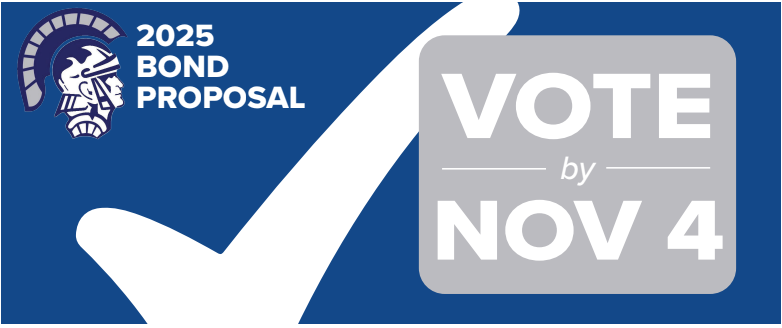
At Fruitport Community Schools, we are grateful to be part of a community that cares deeply about its students, families, and future. Thank you to everyone who participated in the May 6, 2025 election. While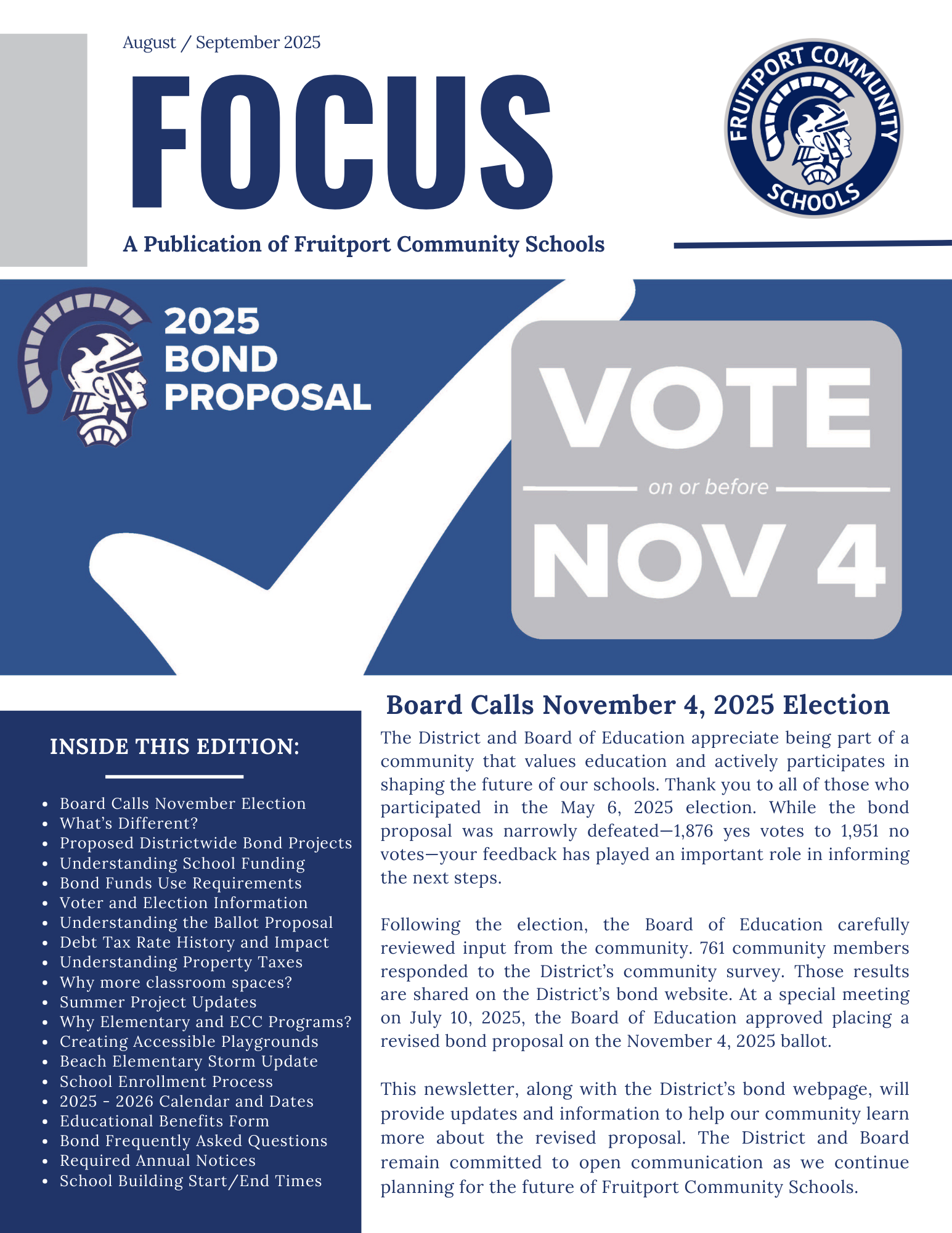 the most recent bond proposal on May 6, 2025 was narrowly defeated—1,876 yes votes to 1,951 no votes—your engagement, feedback, and dedication to our schools have helped guide our next steps.
the most recent bond proposal on May 6, 2025 was narrowly defeated—1,876 yes votes to 1,951 no votes—your engagement, feedback, and dedication to our schools have helped guide our next steps.
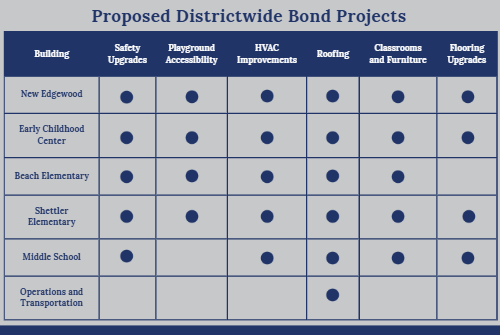 In response, the Board of Education has taken time to listen, reflect, and refine. At a special meeting held on July 10, 2025, the Board approved placing a revised bond proposal on the November 4, 2025 ballot. This updated plan reflects our continued commitment to creating safe, modern, and effective learning environments that meet the needs of our students, staff, and community.
In response, the Board of Education has taken time to listen, reflect, and refine. At a special meeting held on July 10, 2025, the Board approved placing a revised bond proposal on the November 4, 2025 ballot. This updated plan reflects our continued commitment to creating safe, modern, and effective learning environments that meet the needs of our students, staff, and community.
This webpage will serve as a central resource for updates, information, and opportunities for engagement to learn more about the revised bond proposal. Click on the newsletter link to the right for more information also. We sincerely thank our community for its ongoing involvement and support as we work together to build a stronger future for Fruitport.
Bond Communications and Publications
Post May Election Community Bond Survey Results
Following the narrow defeat of the May 6, 2025 bond proposal, Fruitport Community Schools took a thoughtful and proactive approach to better understand the perspectives and priorities of our community. To do this, we launched a comprehensive survey to gather input from students, families, staff, and community members.
This feedback has been instrumental in guiding the refinement of the revised bond proposal. We are grateful to all who took the time to share their thoughts and help shape the future of our schools. Thank you to the 761 community members who completed the survey so that your voice could be heard.
A summary of the results for each survey question is provided below. We invite you to review this information and stay engaged as we continue moving forward—together.
- Did you vote in the May 6, 2025 bond election?
- If you voted in the May 6, 2025 bond election, how did you vote?
- What was the reason for your vote choice?
- How well informed did you feel about the projects identified in the bond proposal prior to the May 6, 2025 vote?
- Since the bond proposal was defeated, what would have made it more likely for you to support the bond proposal?
- What aspects of the bond proposal were most important to you?
- Do you feel that the District effectively communicated the bond proposal's goals and benefits?
- How do you prefer to receive updates or information from the District?
- What concerns, if any, do you have about future bond proposals?
- What advice or feedback do you have for the District and the Board of Education as they consider next steps?
What's Different from the May 2025 Bond Proposal?
As the District and Board of Education continue working to ensure that our facilities meet the evolving needs of our students, staff, and community, the November 2025 bond proposal differs from the May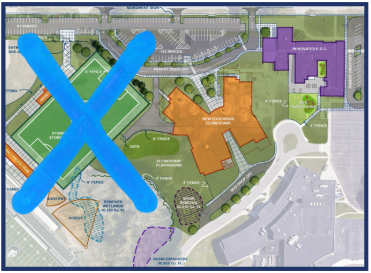 2025 proposal in the following ways. The November proposal reflects community feedback and district priorities, and includes three (3) key changes:
2025 proposal in the following ways. The November proposal reflects community feedback and district priorities, and includes three (3) key changes:
- Reduced Bond Dollar Amount: The overall bond request has been decreased, while still supporting critical facility updates.
- Adjusted Project Scope: The soccer field and outdoor concession stand/restroom facility have been removed from the proposal. This decision helps focus resources on the most essential infrastructure needs across the district.
- Enhanced School Improvements: The revised bond proposal now includes additional renovations to elementary school buildings and the middle school, helping ensure learning environments are safe, modern, and more up to date.
November 4, 2025 Bond Proposal Project Scope
Fruitport Community Schools voters will be asked to consider a bond proposal on the November 4, 2025 election ballot. If approved, there is expected to be a zero (0) tax rate increase from the current rate for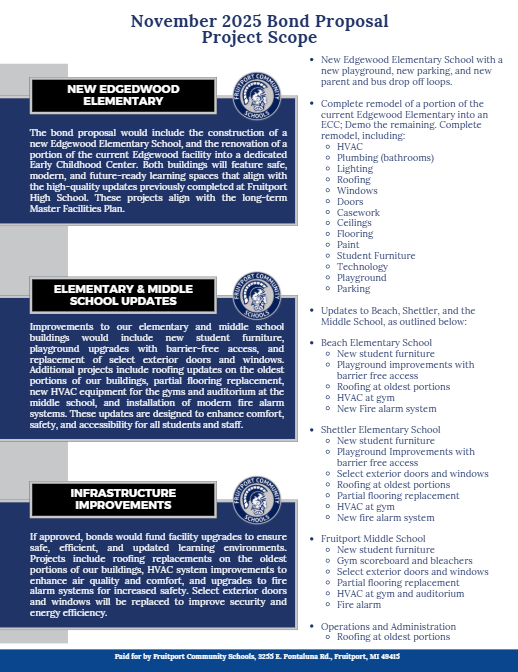 property owners, and it would authorize the District to borrow $78.5 million to fund capital improvements throughout the district. These projects are outlined in the document image to the right.
property owners, and it would authorize the District to borrow $78.5 million to fund capital improvements throughout the district. These projects are outlined in the document image to the right.
The bond proposal would be designed to create safe and modern learning spaces, while improving accessibility to playground spaces and elementary and early childhood experiences for families.
Additionally, the bond proposal would allow the District to address aging systems at the end of their useful life cycle. The District has created a long term Master Facilities Plan that involves asking voters to consider bond proposals as current debt is retired, allowing long term facility improvements across the District without increasing the debt levy from the current rate.
The bond proposal would invest in high quality early childhood education, while creating space to support growing enrollment, expanding student needs, and access to modern, functional learning environments for all.
Proposed Site Plan and Renderings
The images below represent renderings of the proposed Edgewood Elementary School. The proposed site plan is also included. As you will see in the site plan, the soccer field and outdoor restroom and concession stand facility have been eliminated. The area that was dedicated to become a soccer field in the May 2025 bond proposal site plan is now dedicated to become an open grassy field to preserve green space on the site.
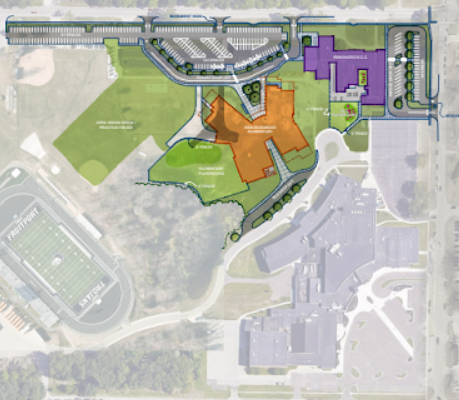 |  |
| Proposed Site Plan | Edgewood Elementary Rendering |
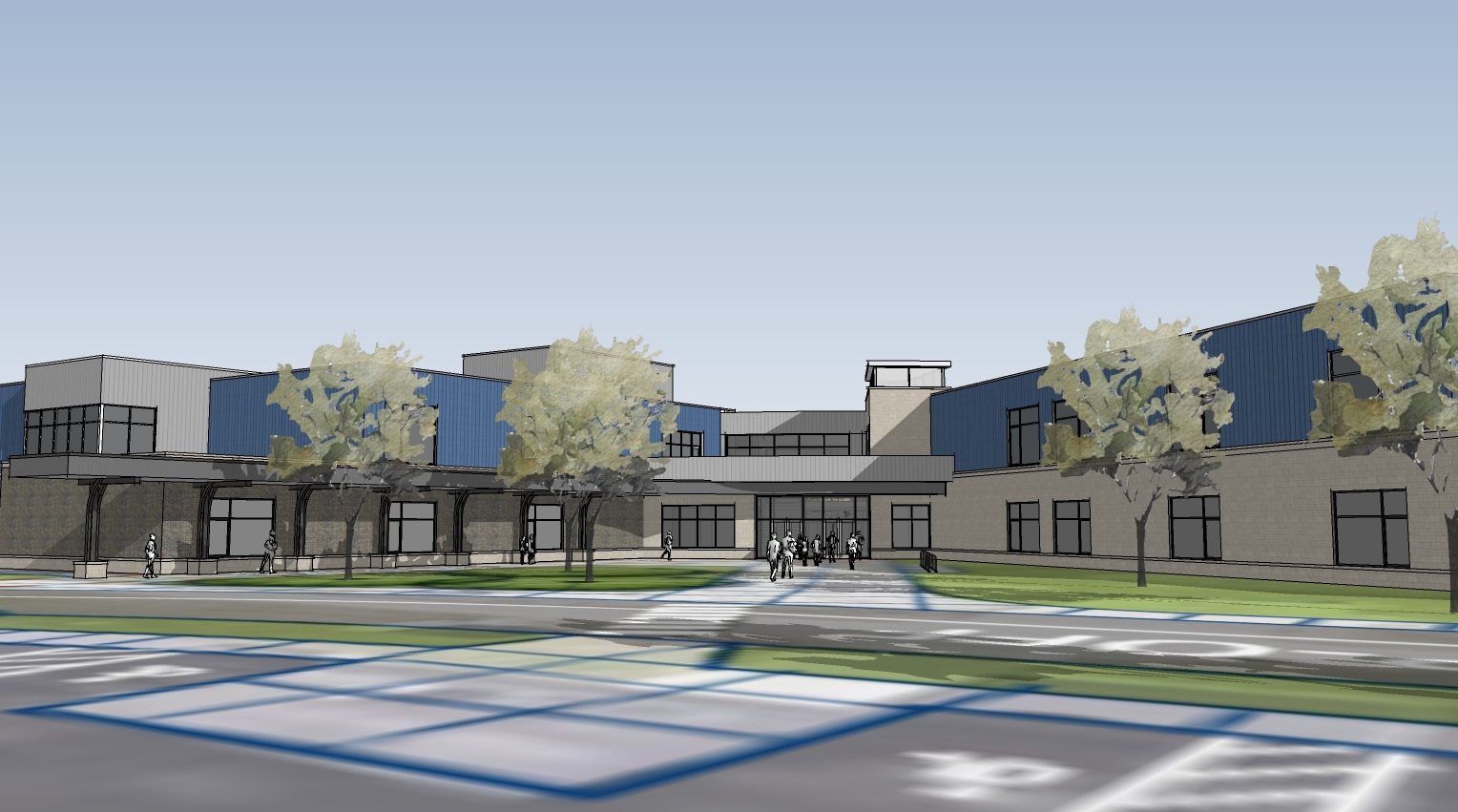 | 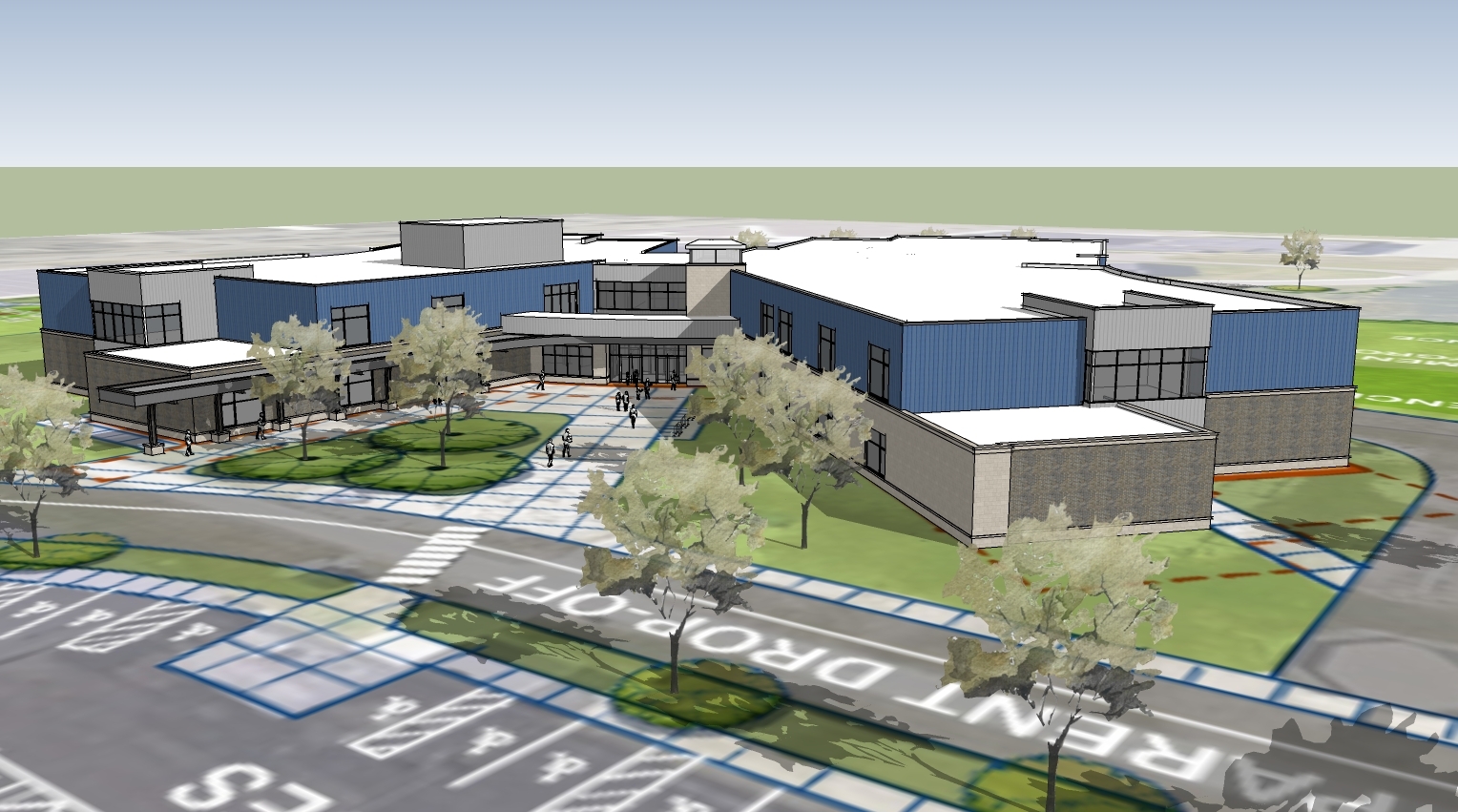 |
| Edgewood Elementary Rendering | Edgewood Elementary Rendering |
Understanding the Ballot Language
Shall Fruitport Community Schools, Muskegon and Ottawa Counties, Michigan, borrow the sum of not to exceed Seventy-Eight Million Five Hundred Thousand Dollars ($78,500,000) and issue its general obligation unlimited tax bonds therefor, in one or more series, for the purpose of:
acquiring, erecting, completing and remodeling school buildings, facilities, and additions to school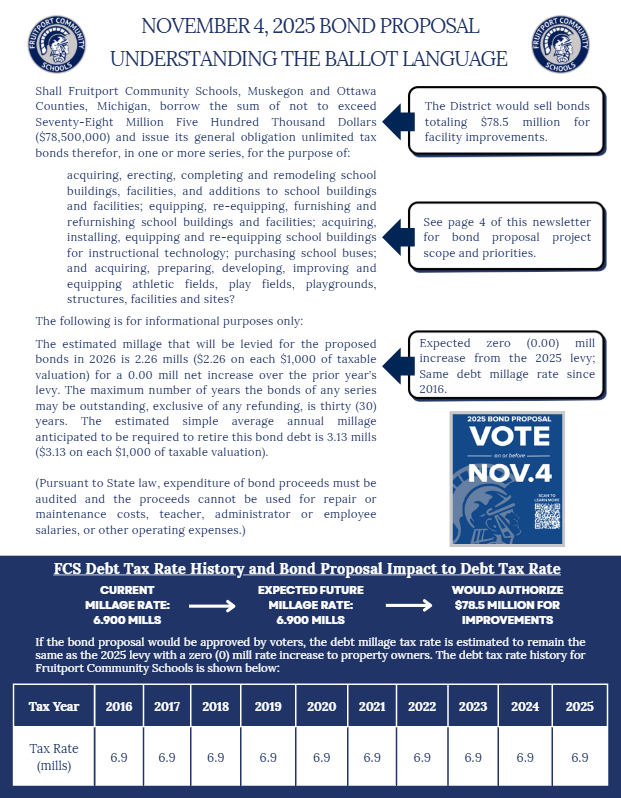 buildings and facilities; equipping, re-equipping, furnishing and refurnishing school buildings and facilities; acquiring, installing, equipping and re-equipping school buildings for instructional technology; purchasing school buses; and acquiring, preparing, developing, improving and equipping athletic fields, play fields, playgrounds, structures, facilities and sites?
buildings and facilities; equipping, re-equipping, furnishing and refurnishing school buildings and facilities; acquiring, installing, equipping and re-equipping school buildings for instructional technology; purchasing school buses; and acquiring, preparing, developing, improving and equipping athletic fields, play fields, playgrounds, structures, facilities and sites?
The following is for informational purposes only:
The estimated millage that will be levied for the proposed bonds in 2026 is 2.26 mills ($2.26 on each $1,000 of taxable valuation) for a 0.00 mill net increase over the prior year’s levy. The maximum number of years the bonds of any series may be outstanding, exclusive of any refunding, is thirty (30) years. The estimated simple average annual millage anticipated to be required to retire this bond debt is 3.13 mills ($3.13 on each $1,000 of taxable valuation).
(Pursuant to State law, expenditure of bond proceeds must be audited and the proceeds cannot be used for repair or maintenance costs, teacher, administrator or employee salaries, or other operating expenses.)
School Funding in Michigan
School funding in Michigan is complex and built on three primary sources: state funding, local property taxes, and federal support. Each plays a unique role in providing the financial resources necessary to operate public schools.
Roughly 60-70% of a district’s budget comes from the State through the School Aid Fund (SAF). Most of these funds are distributed through the foundation allowance, which provides a set amount of money per student. This per-pupil amount is determined annually by the State. These funds support everyday operations such as teacher salaries, classroom supplies, utilities, and other essential costs.
Also, the SAF distributes money through categorical grants. These are targeted for specific needs, such as transportation or support for at-risk students. Some grants are automatically provided based on district characteristics, while others require an application. The SAF is funded through state sales taxes, income taxes, lottery proceeds, and other state revenues.
The second-largest funding source comes from property taxes levied at the local and county levels. While property taxes once made up nearly all of a district’s funding, a major reform in 1994 (Proposal A) shifted the balance to reduce this burden, and increased the state sales tax to help fund schools.
Today, local operating millages, approved by voters, supplement state funding. However, these millages are generally collected only on non-homestead properties (e.g., businesses, rental properties, second homes).
Districts may also propose sinking funds or bond issues to finance capital projects like building renovations or new construction. These voter-approved taxes apply to all properties, including primary residences, and are used for maintaining and improving school facilities.
Voter approved bond funds may only be used on projects described in the ballot proposal, and can not be used on operational expenses, such as employee salaries and benefits. Bond funds must be kept separate from operating funds, and must be audited by an independent auditing firm.
Lastly, federal funds make up 5-10% of a district’s overall budget. These dollars are typically designated for specific programs such as special education, school nutrition, or support for students from low-income households.
Our District remains committed to being good stewards of public funds while providing high-quality education for every student. The audited financial statements and Board approved annual budget can be found on the District’s transparency reporting webpage.
education for every student. The audited financial statements and Board approved annual budget can be found on the District’s transparency reporting webpage.
Schools are assigned a fiscal indicator score, which is a high level, single digital metric designed to give a quick look at how a school or community is faring fiscally considering changing economic climates. The lower the score, the more fiscally stable. For four (4) straight years, Fruitport Community Schools has been assigned a fiscal indicator score of zero (0), the best a school can be assigned!

Property Taxes and Taxpayer Impact
The District is committed to transparency and helping our community understand how local property taxes support public education.
In Michigan, property taxes for schools are based on a property's taxable value, not its market value. Taxable value is determined by a local assessment and is typically 50% of the property’s market value. Each year, the taxable value can only increase by the rate of inflation or 5%—whichever is lower—unless there is a transfer of ownership or new construction, which may reset the value. This system allows for more predictable and gradual tax increases, even when market values rise more sharply.
In Fruitport, the District levies a 6.9 mill debt tax rate to pay debt service on voter-approved bonds that financed projects and facility improvements across the District.
This debt millage has remained consistent since 2016, as shown on the previous page, providing stability for taxpayers. However, as local taxable values increase due to inflation or new development, the amount of taxes paid by any individual property owner might increase or decrease, even though the rate itself remains unchanged.
These funds are used for bond allowable expenses that improve our infrastructure, while providing safe and modern learning environments for students. The District has created a long term Master Facilities Plan that involves asking voters to consider bond proposals as current debt is retired, allowing long term facility improvements across the District without increasing the debt levy from the current rate.
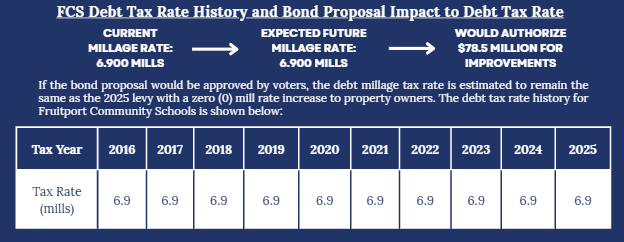
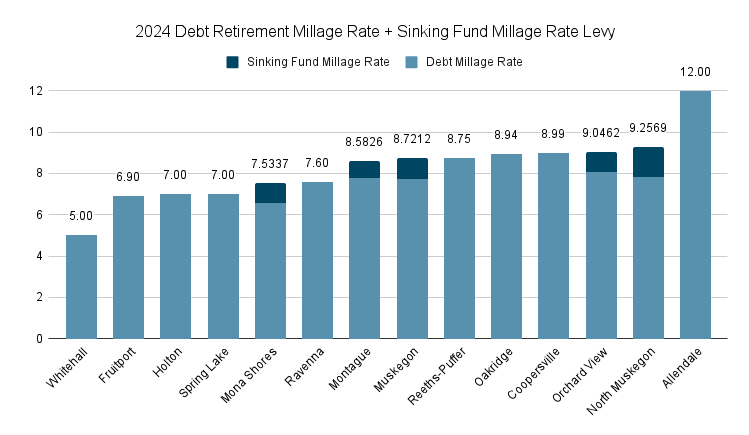
Voter and Election Information
The election polls will open at 7:00 a.m. and close at 8:00 p.m. on Tuesday, November 4, 2025. Absent voter ballots must be available by Thursday, September 25, 2025 to be sent to members of the general public.
Voter Registration Information:
To learn more about voter registration, such as eligibility requirements, how to register to vote in Michigan, and updating or canceling your voter registration, please click on the link below:
Methods and requirements for voter registration depend on the following deadlines:
- If there are 15 days or more before the election, voters can register online, by mail, or in person.
- Voters may register in person through Tuesday, November 4, 2025 (Election Day) with the required documentation.
Absentee Voting:
All registered voters in Michigan have the right to vote by mail using an absentee ballot delivered to their home. Voters can also request an absentee ballot directly from their local clerk’s office. Absentee ballots are available beginning 40 days prior to every election.
Michigan voters can decide to be placed on a permanent absentee ballot list. The local clerk will then mail them an absentee ballot for all local, state, and federal elections. For more information about absentee voting, visit the website below:
Paid for by Fruitport Community Schools, 3255 E. Pontaluna Rd., Fruitport, MI 49415

